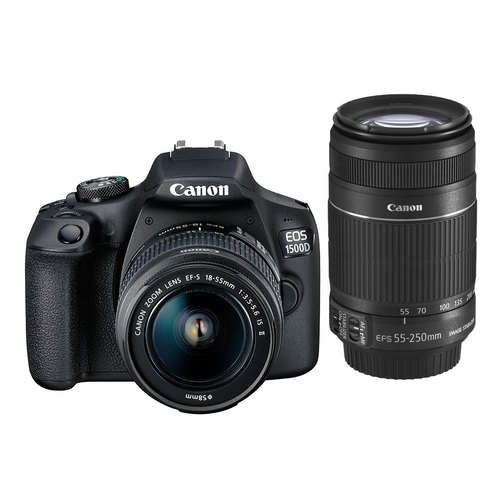











Canon EOS-1D X Mark III DSLR Camera (Body Only)
Cameras
Key Features
- 20.1MP Full-Frame CMOS Sensor
- EOS iTR AF X 191-Point AF System
- DIGIC X Image Processor
- Dual Pixel CMOS AF, 525 Selectable Areas
Overview
Built for speed, sensitivity, and precision, the Canon EOS-1D X Mark III is a powerful DSLR designed for sports, wildlife, and other trying and dynamic imaging applications. Designed as the flagship of the EOS system, the 1D X Mark III is characterized by its refined processing capabilities and distinct speed to suit both photo and video applications. Featuring a newly designed 20.1MP full-frame CMOS sensor and updated DIGIC X image processor, this camera is capable of continuous shooting rates up to 16 fps with the optical viewfinder or 20 fps in live view, with a 1000-shot buffer when shooting raw+JPEG. Complementing this speed is an impressive native sensitivity range from ISO 100-102400, that can be expanded to ISO 50-819200, to suit working in a variety of lighting conditions. Also benefitting the speed is the EOS iTR AF X autofocus system, which uses 191 points for quickly and accurately acquiring focus. It also enables Face Tracking and Head Detection AF functions, which use Deep Learning Technology, to maintain critical focus on moving subjects. Additionally, when working in live view, Dual Pixel CMOS AF uses 3869 manually selectable points and provides a smooth, natural focusing quality akin to the way a camcorder acquires focus.
In addition to high performance stills shooting, the 1D X Mark III is also highly competent for video, with the ability to record DCI 4K content internally at up to 60 fps with 10-bit, 4:2:2 color, as well as Full HD at 120 fps and raw 5.5K (5472 x 2886) at 60 fps. Complementing recording is Movie Digital IS, manual focus peaking, and Focus Guide, and, also, Canon Log Gamma can be used for greater color grading control in post.
Complementing the imaging capabilities is one of the key features of 1D-series cameras: a durable and robust body design. This camera uses a magnesium alloy construction that is weather-sealed to guard against dust and moisture for working in especially trying environments. The body also incorporates dual CFexpress memory card slots to support the fast-continuous shooting rates and high-resolution video capabilities. The optical pentaprism viewfinder is benefitted by an updated mirror drive mechanism for reduced blackout and the 3.2" 2.1m-dot touchscreen LCD is available for intuitive playback and menu navigation. Additionally, built-in Wi-Fi, Bluetooth, and GPS permit seamless wireless connectivity and a built-in Ethernet port allows for faster wired LAN file transferring.
To get you up and running, this camera is delivered in a bundle with a SanDisk 64GB Extreme PRO CFexpress memory card along with an Extreme PRO CFexpress card reader.
20.1MP Full-Frame Sensor and DIGIC X Image Processor
Redesigned 20.1MP full-frame CMOS sensor and DIGIC X image processor yield impressive image quality along with notable speed and sensitivity. The sensor itself is paired with a newly designed low pass filter, which helps to eliminate moiré and other aliasing for an overall clean image quality. The sensor and processor work together to enable up to 20 fps continuous shooting in live view or 16 fps with the viewfinder, and the buffer allows raw+JPEG bursts of up to 1000 frame sequences. Beyond speed, the sensor-processor combination also affords a broad native sensitivity range of ISO 100-102400, which can be expanded to ISO 50-819200 to support working in a wide variety of lighting conditions.
EOS iTR AF X Autofocus and Dual Pixel CMOS AF
Working in conjunction with the redeveloped imaging system, a refined autofocus system, EOS iTR AF X, uses 191 points to quickly and accurately acquire focus on subjects. Of the 191 points, 155 are cross-type points that excel in various lighting conditions and provide increased accuracy on a variety of subject types. This AF system also utilizes Deep Learning Technology to enable refined tracking capabilities, such as Head and Face Detection, for accurate subject recognition.
When recording video or shooting in live view, a Dual Pixel CMOS AF system is employed that features 3869 manually selectable autofocus points, with 525 automatic positions. This focusing system offers smooth and fast focusing performance in a similar manner to how a camcorder acquires focus. Dual Pixel CMOS AF integrates two separate photodiodes within each pixel to provide a broad and dense network of phase-detection gathering elements across a majority of the image sensor to reduce focus hunting for faster, more direct control of focus placement. When working with still imagery, this focusing system works to acquire focus quickly and accurately, making it ideally suited to shooting and tracking moving subjects so that critical focus is attained with each shot. When shooting video, a Movie Servo AF mode offers smooth and natural focusing when changing from different subjects or different distances within the scene, as well as the ability to specify tracking sensitivity, AF speed, and Face Tracking priority. Benefited by the Touch AF system, rack focus is possible simply by touching elements within the scene on the touchscreen in order to change focus in an intuitive manner. Subject tracking in movies is also heightened due to the Dual Pixel CMOS AF system's ability to recognize subjects and maintain focus when working within changing or cluttered scenery.
DCI 4K and 5.5K Raw Video
Beyond stills, the 1D X Mark III is capable of internally recording DCI 4K video at 60 fps with 10-bit 4:2:2 color as well as raw 5.5K video. DCI 4K recording is possible using both the full sensor area or with a cropped portion, and the Canon Log Gamma also provides increased color grading control. Additionally, Full HD recording up to 120 fps is also possible for slow motion playback.
Both All-I and IPB compression options are available, along with the ability to autofocus when shooting at up to 5.5K raw at 30 fps or cropped DCI 4K at 60 fps. When using the full-frame area, 4K autofocus is limited to 30 fps. Also, Movie Digital IS, peaking, and a focus guide can be used to further complement making stable and sharp recordings.
Body Design
- Enhanced optical pentaprism viewfinder works in conjunction with an updated mirror drive mechanism for reduced blackout.
- Rear 3.2" 2.1m-dot LCD has a touchscreen design for intuitive control over playback and menu navigation.
- Dual CFexpress memory card slots cater to the fast-continuous shooting rates and high-resolution video recording and also offer a flexible means for storing and sorting file types.
- Smart Controller on the rear of the body is a touch-sensitive button for quick and intuitive focus point selection while shooting. LP-E19 rechargeable lithium-ion battery offers improved performance compared to previous generation 1D cameras.
- Built-in Wi-Fi, Bluetooth, and GPS offer flexible wireless control and geotagging capabilities, along with the ability to apply IPTC tags to files.
- For physical, wired connectivity, there are integrated USB Type-C, mini HDMI, headphone, microphone, N3 remote, and Ethernet ports. Compatible with optional WFT-E9A Wireless File Transmitter for faster file transferring over wireless LANs.
- Magnesium alloy body design is dust- and weather-resistant for working in inclement conditions.






























